Overview: Best Dynamic Microphone
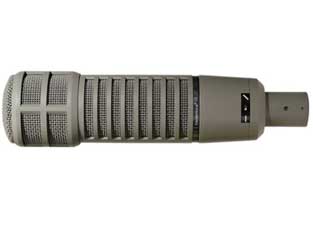
Check Price:
Pros
- One of the best all-purpose mics available
- Natural Sound
- Great for Sung Vocals, Podcasting, Kick drums, Brass
- Very Little Proximity Effect
Cons
- Large size not ideal for some applications
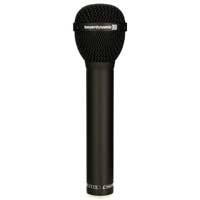
Check Price:
Pros
- One of the best handheld dynamic vocal mics out there
- Quick transient response
- Full lower mids with great detail for vocals
Cons
- Very hot mic – requires good mic technique
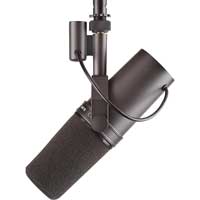
Check Price:
Pros
- Iconic, warm, full sound
- Ideal for Spoken Word or Sung Vocals
Cons
- Large size not ideal for some applications
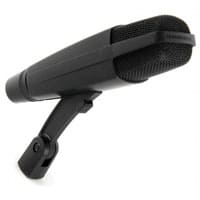
Check Price:
Pros
- Fantastic all-purpose mic
- Great for Vocals, Snares and Toms
Cons
- Included Clip is not very durable or adaptable
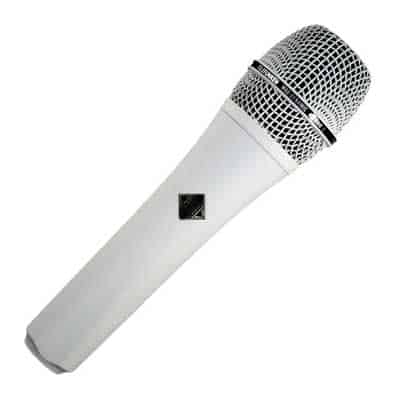
Check Price:
Pros
- One of the best handheld dynamic mics out there
- Comes in any color
- Modern, bright sound with excellent detail that never sounds thin.
Cons
- Requires careful mic technique
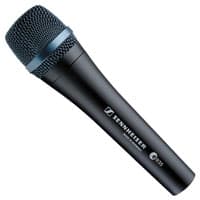
Check Price:
Pros
- Like an SM58 with more detail
- Great for live vocals
- Can be used as a utility mic
Cons
- Sensitive to plosives: requires good mic technique.
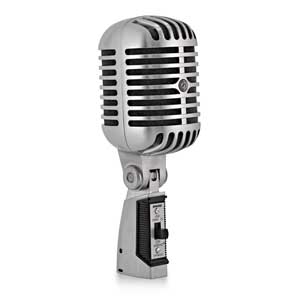
Check Price:
Pros
- Best looking mic in the world
- Has a flattering, limited response.
- Great for live vocals
Cons
- Not so versatile
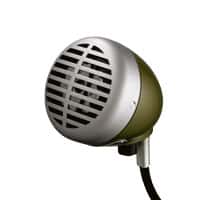
Check Price:
Pros
- Great for lo-fi vocals, or any midrange-only applications
- Adds midrange cut as a second mic to any mix
- Ideal for harmonica
Cons
- Specialist mic for midrange-only applications
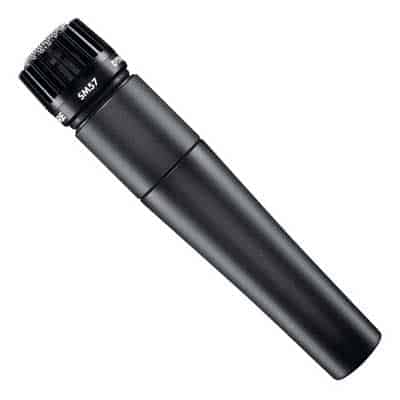
Check Price:
Pros
- THE utility mic that gives workable results on nearly any application
- affordable
- extremely durable
Cons
- Not as detailed as other mics on this list
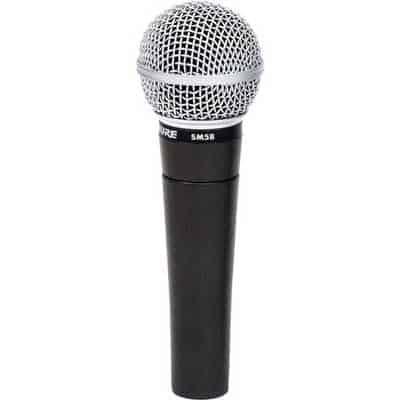
Check Price:
Pros
- The most popular live vocal mic that gives workable results on nearly any application
- affordable
- extremely durable
Cons
- Not as detailed as other mics on this list
Intro
Dynamic microphones are the reliable, go-to mics for live stage and broadcast applications. They are generally more affordable than condenser microphones, and more durable.
For demanding live situations, noisy recording spaces, or mega-loud sound sources, dynamic mics are hands-down the best choice.
Suited to a wide variety of applications, dynamic mics have the following benefits: they are great at rejecting unwanted neighboring noise, they don’t require a power source like 48V phantom power, they have almost zero self-noise, and they are best at handling high sound pressure levels (SPL).
How We Chose the Best Dynamic Microphones
For this guide, we shortlisted and tested 10 of the most popular dynamic microphones and tested them side-by-side. We have limited this list to multi-purpose dynamic mics and those used for vocal applications.
Sound quality, versatility, and price were all considered in the rating.
We wanted to include the Heil PR35 for this review but couldn’t get ahold of one in time. Specialist dynamic mics for kick drums like the Lewitt DTP 340 REX or Heil PR48 will be considered in a different guide.
See here for our guide to mics for podcasting and voice over. See here for all of our mic reviews and info and audio gear guides.
The Test Drive: Listen to the Mics
We used a Universal Audio Apollo Solo Interface recorded with Logic Pro X. To give an idea of the raw sound of the mics, we have resisted the urge to make any post-recording adjustments to the tracks. There is no EQ or compression applied to any of the audio clips here. We adjusted the gain from the audio interface to taste. The guitars are a Martin steel-string acoustic (SP000-16TR), and Fender Strat.
Acoustic Guitar was recorded with the mic pointing at the 12th fret about 1 meter from the body of the guitar.
Full disclosure: We fully acknowledge that there is no one way to use a microphone. Mic placement, how you play or sing, not to mention EQ, compression, impedance, and preamp settings can all have dramatic effects on the final result.
Electro-Voice RE20
our rating
4.8
Check Price:
Bottom Line:
A multi-purpose microphone with unique characteristics. Its large sweet spot, minimal proximity effect, and excellent detail, combine for a very natural sound.
A must-have in any mic locker, the RE20 is a multi-purpose dynamic mic known for its clarity and neutral response. Using what Electro-voice calls Variable-D design, the RE20 has a large sweet spot and very little proximity effect.
Applications Recommended for the Electro-voice RE20
- Podcasting, voice-over, and other spoken word applications
- Sung vocals, especially singers recording with a band in the same room.
- Loud instruments: kick drum, brass instruments, loud bass amps…
Applications NOT Recommended for the Electrovoice RE20
- applications that require different polar patterns other than cardioid
- recording ensembles, or the ambient sound of a room
- cymbals, acoustic guitar, or any application that requires a quick transient response
Build/Design
The RE20 is a fixed-cardioid, dynamic mic with a tank-like rugged build weighing in at 737 grams. It has a low impedance of 150 Ohms and a sensitivity of 1.5 mV.
The RE20 is equipped with an internal shockmount to reduce handling noise and a humbucking coil to guard against interference. It also has a built-in pop filter to reduce plosives.
The RE20 has an onboard high-pass filter that cuts below 400 Hz with more subtlety than most high-pass filters. It only cuts 2.25 dB off the sound as opposed to a typical -5dB.
Its innards have an output transformer, which gives it an interesting harmonic coloration that is not found in most modern dynamic mics.
Sound
With its balanced frequency response, nothing is over-hyped. The neutral response gives you clarity in all registers.
For spoken word applications, it gives you a silky broadcast sound out-of-the-box, with no fiddling necessary. This makes it one of the most popular broadcast mics around.
For sung vocals, the RE20 can almost be used as a handheld as it is very forgiving with mic placement. The mic handles plosives and sibilance with grace, never popping or whistling. And yet, there is brilliance in the upper frequencies where other dynamic mics sound dull.
For kick drums, the RE20 gives you a natural, un-hyped sound. That goes for any instrument you use it on. In live situations, it is the go-to mic for trumpets or brass instruments.
On the whole, the RE20 provides a natural sound that is very workable in a mix. It is utility mic with unique properties. Audio engineers are always happy to have one around.
Beyerdynamic M88 TG
our rating
4.7
Check Price:
Bottom Line:
One of the best handheld dynamic mics out there. With quick transients, detail, and thicker lower-mids, the result is silky and full.
Although this hyper-cardioid dynamic mic is primarily marketed for use on kick drums, the Beyerdynamic M88 has proven its versatility as a vocal and utility mic over the years. (In some circles, it is referred to as the ‘Phil Collins’ mic, as he used it almost exclusively on his vocals.)
First introduced in 1962, the Beyerdynamic M88 TG is the latest incarnation of this classic dynamic mic.
Recommended Applications for the Beyerdynamic M88 TG
- Sung vocals
- Podcasting, voice-over, and other spoken word applications
- Kick drums
- Brass, woodwinds
- Guitar amps
Applications NOT Recommended for the Beyerdynamic M88 TG
- Applications that require polar patterns other than cardioid
- Ensemble recording
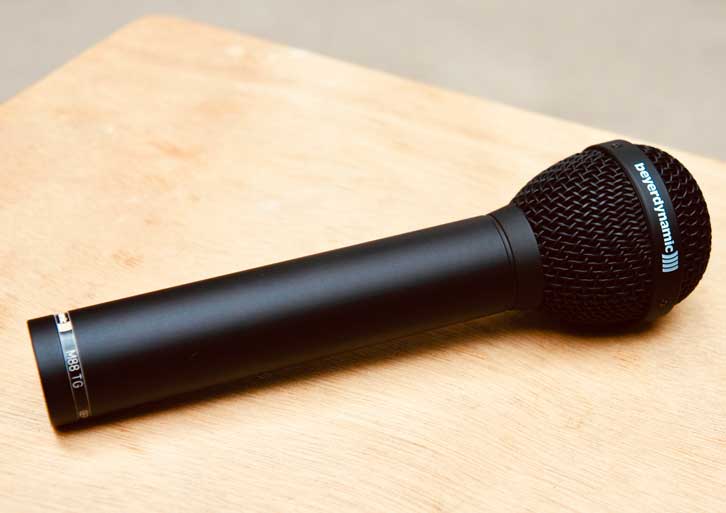
Build
The Beyerdynamic M88 TG has a tank-like build weighing in at 320g, with brass casing and a flat steel grille. Despite its heft, it’s relatively small and petite-sized.
Its capsule has a high sensitivity for dynamic mics (2.3 mV/Pa). The diaphragm is made of Hostapahan, (similar to Mylar) and the magnets are neodymium.
Despite the various versions with different letters after the ‘M88’, the mechanical and acoustic characteristics of the M88 are essentially the same. The M88 TG (which stands for ‘tour group’) has a stronger grille than its predecessors.
Sound
The frequency response of the M88 TG has a significant (8 dB) lift in the upper frequencies, from 2 kHz – 15 kHz. Yet it doesn’t sound overly hyped or tinny. But the M88 TG is definitely not neutral sounding.
Overall, it has a well-produced, out-of-the-box sound. The clarity in the top is notable for a handheld dynamic mic and the lower mids are thick (nice for female vocals).
The plosives pop quite easily. The Beyerdynamic M88 TG is a hot mic that will need careful handling and mic technique. That said, with its hyper-cardioid pattern, the M88 TG is exceptional at rejecting unwanted neighbouring noise.
In our tests, the mic showed excellent consistency in its off-axis response. It sounds nearly identical at 45 degrees as it does at 0 degrees (speaking directly into the end). This is great for live vocals as you won’t need to be so careful with placement to achieve a consistent sound.
As a utility mic, the M88 TG definitely can deliver. The results are a little hyped and not so neutral, but in a good way most of the time. The quick transient response of the Hostapahan diaphragm makes it an excellent choice for kick drums. The fuller lower-mids and detail made it quite pleasing for recording acoustic guitar.
In summary, along with the Telefunken M80 this is one of the best handheld dynamic mics I have used.
Shure SM7B
our rating
4.8
Check Price:
Bottom Line:
One of the finest dynamic mic sounds out there for sung vocals or spoken word applications.
The Shure SM7B is an industry-standard dynamic mic for the studio. Famously used to record Michael Jackson’s Thriller album, it’s been around a long time and had many names (SM-7, SM7A).
See here for a head-to-head comparison of the SM7B with the RE20.
Recommended Applications for the SM7B
- Sung vocals (studio)
- Podcasting, voice-over, and other spoken word applications
- Guitar amps
- Bass amps
Applications NOT Recommended for the SM7B
- Live stage
- Applications that require polar patterns other than cardioid
- Ensemble recording
- Applications that require the lush detail and high sensitivity of a condenser mic (e.g. violin, piano)
Build/Design
Weighing in at 784g, the SM7B is a sizeable mic. This heft is due to its internal air-suspension shock and vibration isolator. This means you do not need a pop filter or a shockmount.
Equipped with backplate switches for bass roll-off, and presence boost (upper mids), the SM7B’s frequency response can be adjusted to fit different voices and recording spaces.
It is important to note that the SM7B requires more gain (about 60dB) from your preamp than most condenser mics. Shure recently released the SM7dB, which is the same mic with an onboard preamp. This is great option to ensure you always have enough gain.
Otherwise, we recommend using a Cloudlifter if your interface or preamp doesn’t have enough juice. This is also an excellent way to provide an extra 20-25 dB of clean gain.
Sound
The advantage of the SM7B is its ability to emphasize sound sources in a smooth, flattering way. The SM7B won’t give you boring, accurate reproduction. It will give you a rosy SM7B kind of reproduction.
To my ears, the SM7B is a very pleasant, warm, full mic for vocals. One of my favorite dynamic mic sounds, in fact.
The sound is less detailed, which is sometimes a good thing. Its proximity effect can be used to your advantage by simply placing the mic closer to the source for the added low end.
Many home recordists love the SM7B because it offers excellent results even in less-than-ideal acoustic spaces. Being a dynamic mic, it does very well at rejecting unwanted reflections and neighboring noise. (like all the other mics on this list)
In short, if you’re looking for a mic for spoken word or sung vocals, this mic will not disappoint.
Sennheiser MD 421-ii
our rating
4.6
Check Price:
Bottom Line:
Great for spoken word, sung vocals, snares, toms, woodwinds, brass – this anonymous-looking beast is a classic, all-purpose mic. Like a fuller, more detailed SM57.
Introduced in 1960 as a broadcast mic, the Sennheiser MD 421-II is a classic, multi-purpose, stage and studio mic that you’ll find inconspicuously hiding in stages and studios around the globe.
Its name/number is easily forgotten and its look is nothing to write home about. And yet, it remains a very reliable, industry standard, all-purpose mic that delivers where it counts – sound.
Recommended applications for the Sennheiser MD 421-II
- Podcasting, voice-over, and other spoken word applications
- Sung Vocals (studio or live stage)
- Toms, snares
- Brass, woodwinds
Applications NOT Recommended for the Sennheiser MD 421-II
- Applications that require polar patterns other than cardioid
- Ensemble recording
Build
As you can see, the Sennheiser MD 421-II is not the sexiest mic out there. Square and anonymous-looking, it’s not likely to win design awards. And yet, in a certain way, it’s almost so square that it’s cool.
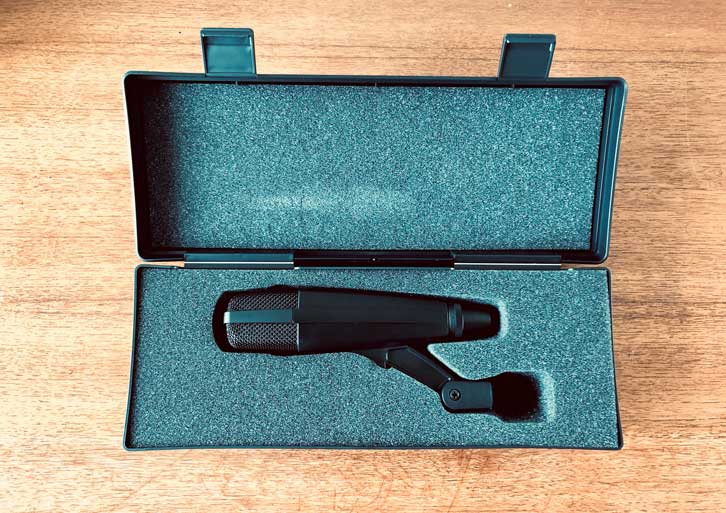
It has an all-steel casing and weighs in at 385g. It comes in the a hard-shell plastic carry case you see above.
It is sometimes difficult to get the right angle for close miking drums, which is in fact what this mic is really good at. The mic clip is the problem here.
The included clip continues to receive complaints from users. It is not that durable or adaptable. I found it annoying that I needed a screwdriver to tighten the hold just to keep it from flopping downward.
Sound
The MD 421-ii is very sensitive, listed at 2mV/Pa.
For vocal applications, this sensitivity is great but sometimes a bit on the hot side. Although I didn’t hear it happening in my monitors, the plosives pop quite a bit in our tests even with careful handling. Sibilance was well controlled by the MD 421-ii.
Elsewhere in your studio, the Sennheiser MD 421-ii can be used anywhere you might use an SM57 with a bit more detail and fullness in the results.
Its slow transient response flatters clicks and mouth sounds on horns and woodwinds. Generally, the slow transients give the MD 421-ii a warmer, rounder edge.
On the whole, this square beast should definitely be on your shortlist if you’re looking for a high-quality, all-purpose mic.
Telefunken M80
our rating
4.9
Check Price:
Bottom Line:
One of the best handheld vocal mics out there. Modern, bright, detailed sound, but never too thin.
Telefunken advertises the M80 as a dynamic mic with the clarity and resolution of a condenser. Curious about the validity of these claims, we tried the M80 out.
Recommended Applications for the Telefunken M80
- Sung Vocals
- Guitar and Bass Amps
Applications NOT Recommended for the Telefunken M80
- applications that require polar patterns other than cardioid
- ensemble recording
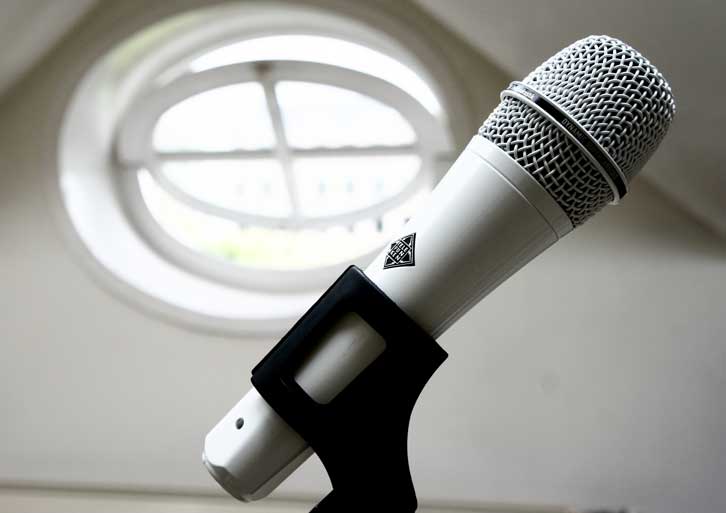
Build
The Telefunken M80 is modeled after the trusty SM58 in its rugged build. With a steel grille, steel casing, and a slip-proof rubber coating, the M80 feels road-ready.
The M80 comes in a rainbow of colors – standard black and silver, turquoise, different woods (oak, cherry), pink, and even gold! (We reviewed the more modest white)
The innards contain a low-mass diaphragm which allows the mic a quicker transient response and higher detail resolution than most dynamic hand-held mics. And unique to this mic, the M80 has a T80 output transformer which may partially account for the lack of harshness in the detail the mic offers.
With a max SPL of 135 and a 1.54 mV/Pa sensitivity rating, the M80 fits the build of a handheld vocal mic.
Sound
With a frequency response from 50 – 18 kHz, the M80 has an obvious boost of around 7 dB from 3K-15K, which would bring edge and definition to any sound.
In our tests, however, the M80 had a bright, detailed response but never sounded tinny or overly hyped. To my ears, it is brighter than any of the other handhelds on this list, but never too thin. Along with the Beyerdynamic M88 TG, it is one of the best handheld dynamic mics I have used.
Like the M88 TG, the Telefunken M80 is not a neutral sounding mic. The results are less-than-neutral but done well: the raw sound requires very little EQ.
On acoustic guitar or as a utility mic, there are better options on this list.
Due to its thin, sensitive diaphragm, the plosives popped quite a bit. The mic definitely requires careful mic technique.
The M80 holds a very consistent, tight cardioid pattern, with very slight off-axis coloration. The Telefunken M81 is a super-cardioid version if you need more rejection of neighbouring noise, or plan to use it in club with low ceilings.
In conclusion, with excellent detail and silky response, this mic has to be considered if you’re looking for a handheld vocal dynamic mic.
Sennheiser E935
our rating
4.5
Check Price:
Bottom Line:
Sounds like an SM58 with more detail. Great choice for live vocals.
The Sennheiser e935, winner of the 2005 TEC award, is a popular choice among handheld vocal mics. The Sennheiser EW-500-G4-935, the wireless version of this mic, is one of the most popular live vocal mics. It comes standard with the e935 capsule.
The Sennheiser e945 is a super-cardioid version of this mic if you need more neighboring noise rejection.
Recommended Applications for the Sennheiser e935
- Sung Vocals
- Guitar and Bass Amps
Applications NOT Recommended for the Sennheiser e935
- applications that require polar patterns other than cardioid
- ensemble recording
Build/Design
About the same size as a Shure SM58, the Sennheiser e935 has a fairly heavy metal body (355 g). The neodymium magnets offer a high output, making this one of the hotter stage mics.
The shock-mounted capsule has a low sensitivity to impact and handling noise. The e935 is lauded for its lack of interference, due to its hum-compensating coil.
Sound
The Sennheiser E935 has noticeable detail in the upper mids. It sounds more natural than an SM58 but still has an overall dynamic mic color.
Due to its high output, the E935 requires good mic technique. Sibilance is quite controlled on the mic, but plosives can pop out if you’re not thinking about the mic position.
In the studio, it produced fairly good results on acoustic guitar and guitar amps which I wasn’t expecting. In this way, it can be used as an alternative utility mic.
Overall, at an affordable price, this is a great handheld vocal mic that should be considered.
See here for our complete review of the e935.
Shure 55SH Series II
our rating
4.6
Check Price:
Bottom Line:
The coolest looking mic with an air-less, covered sound that is surprisingly lovely to listen to. Great for live vocals.
The Shure Unidyne model 55, or the ‘Elvis Mic’, first released in 1939, is still the coolest-looking mic in the world.
Used by famous folks such as Elvis, FDR, JFK, MLK, Indira Gandhi, Patsy Cline, Frank Sinatra, and Ella Fitzgerald (to name a few), the model 55 mic has a defined microphone aesthetic.
The Shure 55SH Series II is the latest incarnation of this classic.
Recommended Applications for the Shure 55SH Series II
- Live Vocals
- Spoken Word Applications
Applications NOT Recommended for the Shure 55SH Series II
- Ensemble recording
- Applications that require polar patterns other than cardioid
- Anything that needs condenser-like detail
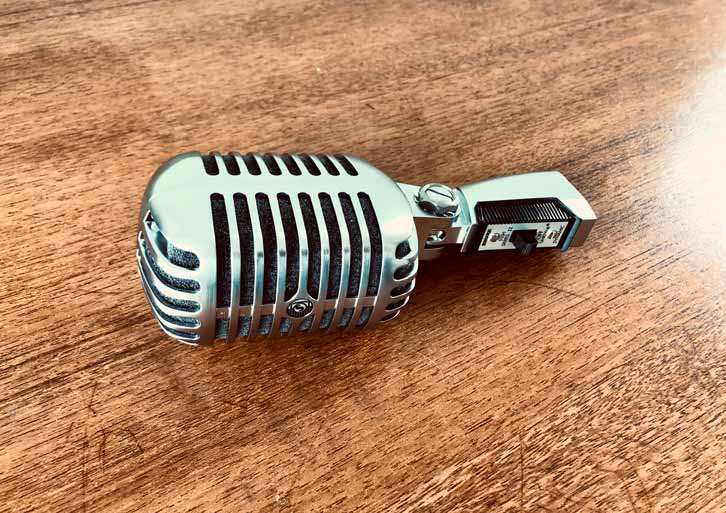
Build
The Shure 55SH Series II mic, weighs a hefty 624 g, with a chrome-plated dye casting.
The 55SH is a fixed-cardioid mic equipped with standard tools for live vocals. Handling noise is limited by the internal shockmount. The built-in pop filter controls vocal plosives. And, it has a good old on-off switch.
The series II has replaced the original capsule with a modern cardioid capsule with a low-impedance configuration.
Sound
The Shure 55SH Series II has a 9 dB boost from 6-7 kHz
The 55SH has a frequency response of 50-15kHz and has a steep roll-off at the top starting at 10 kHz. This results in a sort of air-less, covered sound, that is surprisingly pleasant to listen to.
With a 9 dB boost from 6-7 kHz, there’s a brilliant/sibilant edge to vocals not unlike the SM57. The 55SH has a large consistent sweet spot, with its full cardioid pattern. The proximity effect is quite pronounced.
Overall, I was surprised by this mic. I thought it was just a looker, but the sound for spoken word and sung vocals is much better than I thought. The response is limited in a flattering way. It won’t give you condenser-like lushness but it also won’t give you condenser-like unwanted sound reflections.
For live vocals, it still looks the coolest. If its limited response matches your voice and vocal style, you win on both fronts.
Shure 520DX ‘Green Bullet’
our rating
4.8
Check Price:
Bottom Line:
A specialist mic for harmonica that can do wonders in the studio. Great for lo-fi vocals and adding midrange cut to any recording.
Famous for its classic blues harp sound, this specialist mic for harmonica players has become a stage and studio favorite. Don’t let the label fool you – this is more than just a harmonica mic.
The frequency response is officially 100 Hz – 5 kHz, but with severe roll-offs on the top and bottom, it is more like 500 Hz – 4 kHz. In other words, midrange only.
Seeing how everyone wants to do takes with a Green Bullet these days, we had to include this green gem on this list.
Recommended Applications for the Shure 520DX
- Harmonica
- Live and Studio Vocals (lo-fi, old radio effect)
- Used as a second mic on any application where you want midrange punch. With a detailed condenser and this mic mixed, you can achieve some great results.
Applications NOT Recommended for the Shure 520DX
- Any application where high or low frequencies are important
Build
The 520DX looks like an art-deco grenade. Contoured to fit between a harmonica and your hands, it is a heavy piece of metal. (737g) It looks as if it will last your lifetime and your grandchild’s.
The volume control allows immediate control of the Green Bullet’s high output. Unfortunately, this gets in the way of a standard mount, but special 520 DX mounts are available.
With a permanently attached cable, the Green Bullet is wired for high-impedance, un-balanced operation with a 1/4-inch jack.
The mic can also be rewired to connect directly to a low-impedance device (like a mixer).
Sound
The sound of the Green Bullet holds a special place in my heart. It does the whole midrange lo-fi thing really well, from source. Capturing expression and color in its own way, it’s not simply a ‘cheap mic’ sound
In our test examples, you can hear it on solo voice and acoustic guitar. But using it as a second mic to mix in is really where this mic shines.
This technique can be applied to drum ambiance, guitar amps, vocals, and anything. Adding more 520DX in a song’s bridge, for example, can bring a midrange cut.
And, by the way, it’s good for amplifying and recording harmonica.
Shure SM57
our rating
4.9
Check Price:
Bottom Line:
The industry standard utility mic that can give you a workable sound on nearly any application.
The Shure SM57 is the go-to utility mic in the studio and on stage alike. It can give you a workable sound on almost any application you can think of. Like its brother, the SM58, it is famous and indestructible.
Although the SM58 is technically the ‘vocal mic’ of the two brothers, the SM57 has been used effectively as a vocal mic by many artists (John Lennon, Prince, and Drake, to name a few).
See here for a head-to-head comparison of the SM57 and the SM58.
Recommended Applications for the SM57
- Vocals
- Snares, toms
- Guitar amps
Applications NOT Recommended for the SM57
- Most studio vocals or anything that requires the detail and sensitivity that condenser mics provide
- Podcasting, Voice-over, or other Spoken Word Applications
- Applications that require different polar patterns other than cardioid
- Recording ensembles, or the ambient sound of a room
Build
With the same Unidyne III capsule as the SM58, the SM57 differs only in its grille design. The flat grille on the SM57 allows a closer, stronger proximity effect and causes a frequency response boost of around 6 kHZ, giving the SM57 more brilliance/sibilance.
The flat grille makes the SM57 more suited to guitar cabinets, snares, or any situation where an increased proximity effect might be useful.
Both mics have what Shure calls a “pneumatic shock-mount system”. This insulates the internal cartridge from mechanical vibration. As a result, Shure SM series mics have lower handling noise.
Sound
With the SM57 you’ve got a mic that records nearly anything and gives you a sound somewhere in the range of respectable to good, at a great price.
If you want to use it as a vocal mic, the Shure A2WS windscreen/grille gives you the same pop filter as the SM58.
Shure SM58
our rating
4.8
Check Price:
Bottom Line:
The most popular mic for live vocals. Delivers a ‘good enough’ sound in nearly any setting.
The Shure SM58 is the go-to live vocal mic, famous around the globe. It is the benchmark for handheld vocal mics. It is affordable, indestructible, and it gives quality results.
Recommended Applications for the SM58
- Live vocals
- Any situation where a workable sound will do
Applications NOT Recommended for the SM58
- Most studio vocals or anything that requires the detail and sensitivity that condenser mics provide
- Podcasting, Voice over, or Spoken word applications.
- Applications that require different polar patterns other than cardioid
- Recording ensembles, or the ambient sound of a room
Shure SM58: Build
The SM58 is built like a tank and nearly all the parts are replaceable.
People have put these things in microwaves, dropped them from buildings, and frozen them in carbonite and somehow the mic still works. (Look it up if you’re bored)
The SM58 has a ball grille with a built-in wind and pop filter with a Unidyne III capsule inside.
Sound
Anything you use this mic for will provide you with a usable sound. That’s what makes it a wonder of engineering. With some EQ and compression, you could get away with this setup for a lot of gigs and recordings.
The SM58 has a lack of detail, and some complain about the ‘boxy’ sound of it. But, it will always provide a workable sound.
Questions or Comments?
Follow the discussion here on Facebook.